LSBM304 Cross-Cultural Management: Analyzing 'An Own Goal' Case Study
VerifiedAdded on 2023/06/13
|10
|2805
|478
Case Study
AI Summary
This case study delves into the cross-cultural management challenges encountered by Wilhelm, a football agent, in his dealings with Mr. Haider, utilizing the case study "An Own Goal." The analysis employs Trompenaars' seven dimensions of culture to dissect the behaviors of both individuals, highlighting issues such as universalism vs. particularism, individualism vs. communitarianism, and specific vs. diffuse orientations. It identifies communication barriers, differing decision-making styles, and varying attitudes towards disclosure as key challenges faced by Wilhelm's business. Furthermore, the study explores how cultural value orientations affect management issues, emphasizing the importance of balancing work and personal life. The report concludes by recommending actions based on Hofstede's cultural dimensions to manage cultural issues effectively, advocating for clear power distribution, collectivism, and understanding cultural approaches to negotiation. The ultimate goal is to foster a respectful environment that facilitates target achievement for all parties involved. Desklib provides similar solved assignments for students.

Cross cultural
management issue
management issue
Paraphrase This Document
Need a fresh take? Get an instant paraphrase of this document with our AI Paraphraser
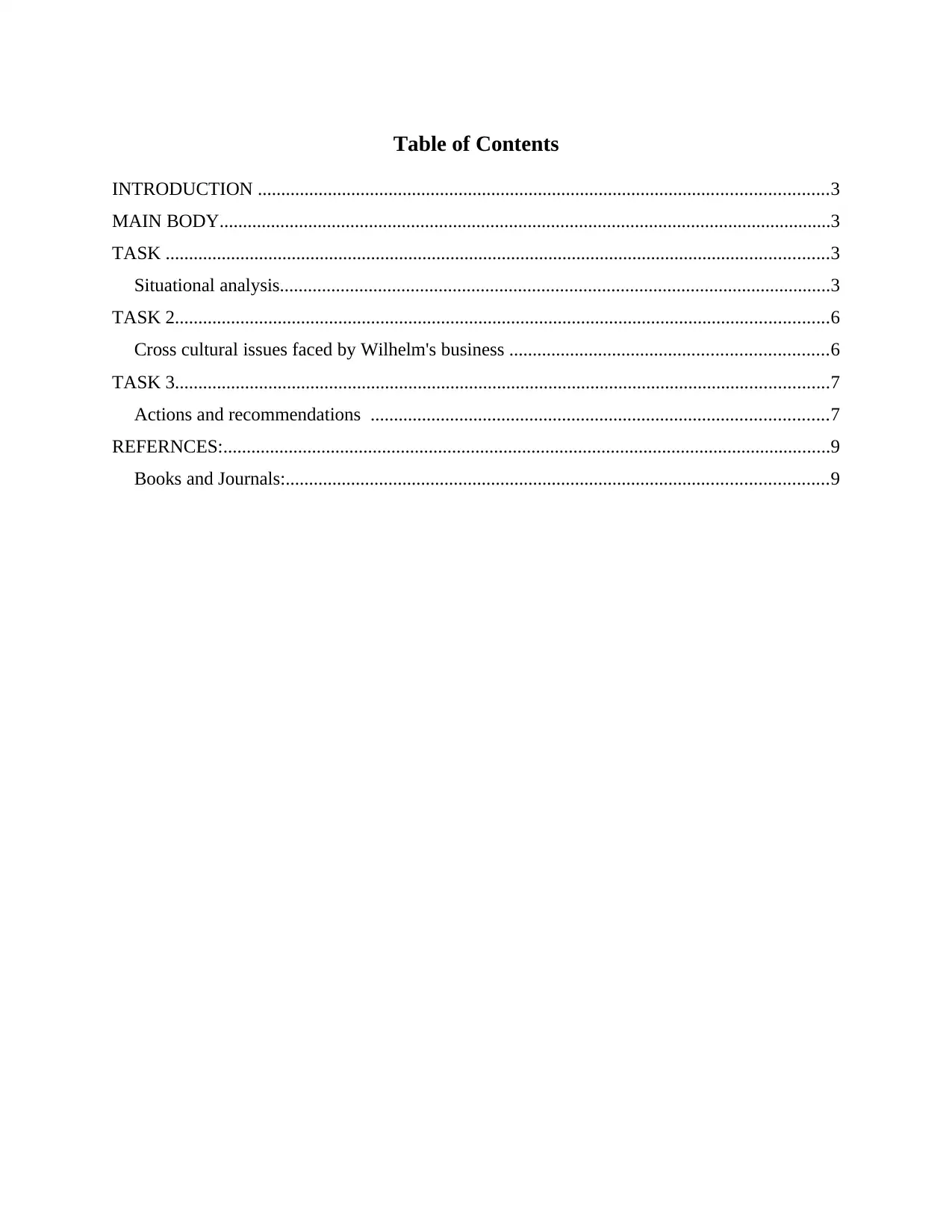
Table of Contents
INTRODUCTION ..........................................................................................................................3
MAIN BODY...................................................................................................................................3
TASK ..............................................................................................................................................3
Situational analysis......................................................................................................................3
TASK 2............................................................................................................................................6
Cross cultural issues faced by Wilhelm's business ....................................................................6
TASK 3............................................................................................................................................7
Actions and recommendations ..................................................................................................7
REFERNCES:..................................................................................................................................9
Books and Journals:....................................................................................................................9
INTRODUCTION ..........................................................................................................................3
MAIN BODY...................................................................................................................................3
TASK ..............................................................................................................................................3
Situational analysis......................................................................................................................3
TASK 2............................................................................................................................................6
Cross cultural issues faced by Wilhelm's business ....................................................................6
TASK 3............................................................................................................................................7
Actions and recommendations ..................................................................................................7
REFERNCES:..................................................................................................................................9
Books and Journals:....................................................................................................................9
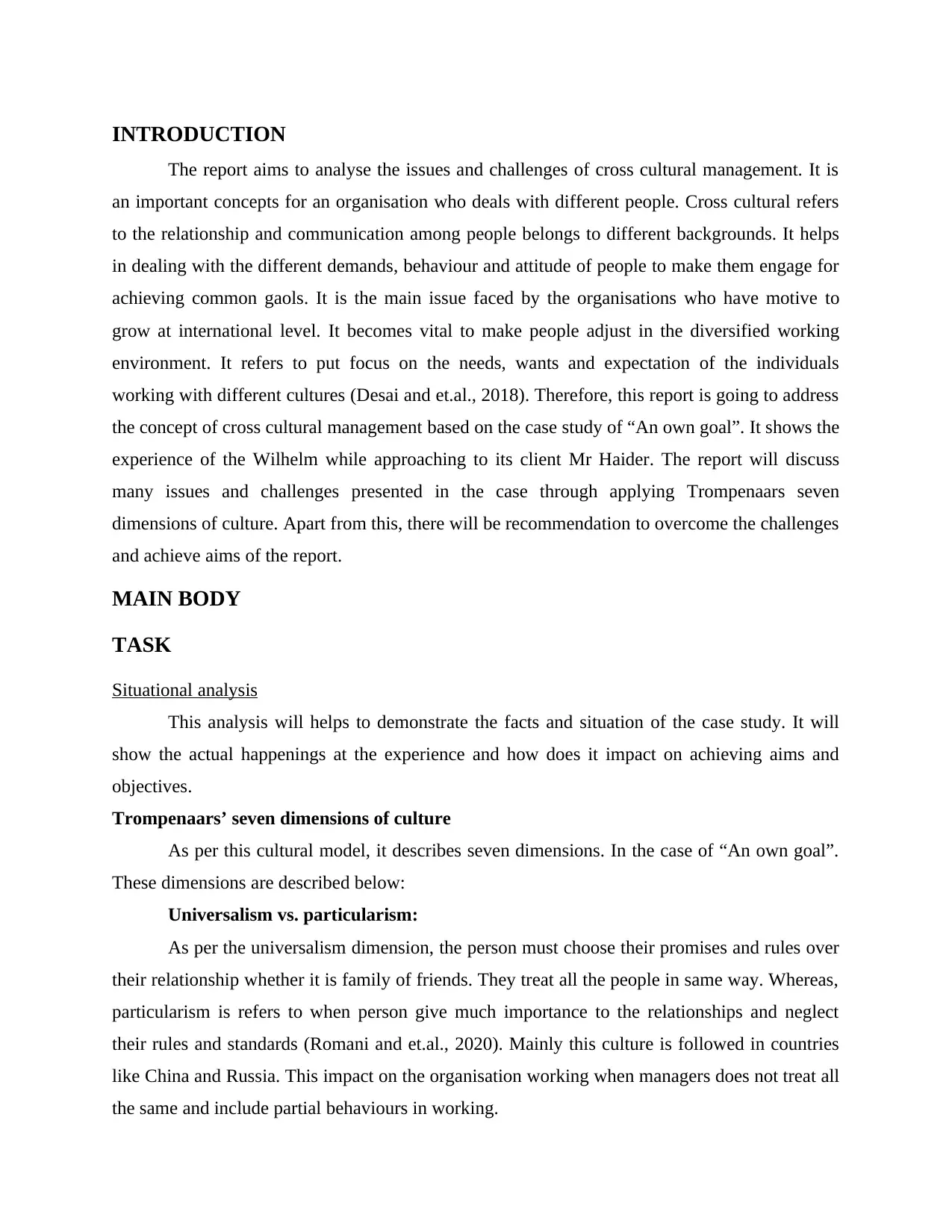
INTRODUCTION
The report aims to analyse the issues and challenges of cross cultural management. It is
an important concepts for an organisation who deals with different people. Cross cultural refers
to the relationship and communication among people belongs to different backgrounds. It helps
in dealing with the different demands, behaviour and attitude of people to make them engage for
achieving common gaols. It is the main issue faced by the organisations who have motive to
grow at international level. It becomes vital to make people adjust in the diversified working
environment. It refers to put focus on the needs, wants and expectation of the individuals
working with different cultures (Desai and et.al., 2018). Therefore, this report is going to address
the concept of cross cultural management based on the case study of “An own goal”. It shows the
experience of the Wilhelm while approaching to its client Mr Haider. The report will discuss
many issues and challenges presented in the case through applying Trompenaars seven
dimensions of culture. Apart from this, there will be recommendation to overcome the challenges
and achieve aims of the report.
MAIN BODY
TASK
Situational analysis
This analysis will helps to demonstrate the facts and situation of the case study. It will
show the actual happenings at the experience and how does it impact on achieving aims and
objectives.
Trompenaars’ seven dimensions of culture
As per this cultural model, it describes seven dimensions. In the case of “An own goal”.
These dimensions are described below:
Universalism vs. particularism:
As per the universalism dimension, the person must choose their promises and rules over
their relationship whether it is family of friends. They treat all the people in same way. Whereas,
particularism is refers to when person give much importance to the relationships and neglect
their rules and standards (Romani and et.al., 2020). Mainly this culture is followed in countries
like China and Russia. This impact on the organisation working when managers does not treat all
the same and include partial behaviours in working.
The report aims to analyse the issues and challenges of cross cultural management. It is
an important concepts for an organisation who deals with different people. Cross cultural refers
to the relationship and communication among people belongs to different backgrounds. It helps
in dealing with the different demands, behaviour and attitude of people to make them engage for
achieving common gaols. It is the main issue faced by the organisations who have motive to
grow at international level. It becomes vital to make people adjust in the diversified working
environment. It refers to put focus on the needs, wants and expectation of the individuals
working with different cultures (Desai and et.al., 2018). Therefore, this report is going to address
the concept of cross cultural management based on the case study of “An own goal”. It shows the
experience of the Wilhelm while approaching to its client Mr Haider. The report will discuss
many issues and challenges presented in the case through applying Trompenaars seven
dimensions of culture. Apart from this, there will be recommendation to overcome the challenges
and achieve aims of the report.
MAIN BODY
TASK
Situational analysis
This analysis will helps to demonstrate the facts and situation of the case study. It will
show the actual happenings at the experience and how does it impact on achieving aims and
objectives.
Trompenaars’ seven dimensions of culture
As per this cultural model, it describes seven dimensions. In the case of “An own goal”.
These dimensions are described below:
Universalism vs. particularism:
As per the universalism dimension, the person must choose their promises and rules over
their relationship whether it is family of friends. They treat all the people in same way. Whereas,
particularism is refers to when person give much importance to the relationships and neglect
their rules and standards (Romani and et.al., 2020). Mainly this culture is followed in countries
like China and Russia. This impact on the organisation working when managers does not treat all
the same and include partial behaviours in working.
⊘ This is a preview!⊘
Do you want full access?
Subscribe today to unlock all pages.

Trusted by 1+ million students worldwide
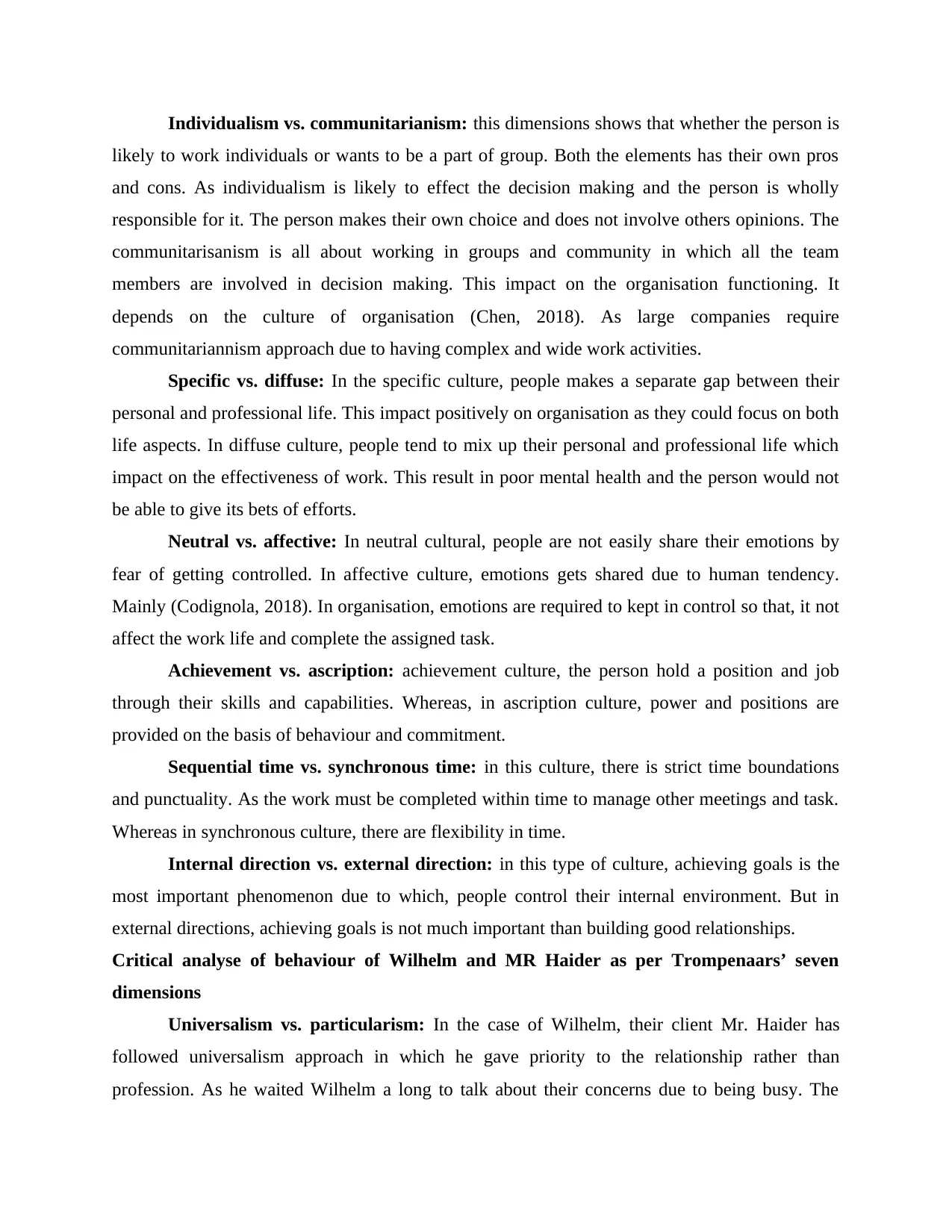
Individualism vs. communitarianism: this dimensions shows that whether the person is
likely to work individuals or wants to be a part of group. Both the elements has their own pros
and cons. As individualism is likely to effect the decision making and the person is wholly
responsible for it. The person makes their own choice and does not involve others opinions. The
communitarisanism is all about working in groups and community in which all the team
members are involved in decision making. This impact on the organisation functioning. It
depends on the culture of organisation (Chen, 2018). As large companies require
communitariannism approach due to having complex and wide work activities.
Specific vs. diffuse: In the specific culture, people makes a separate gap between their
personal and professional life. This impact positively on organisation as they could focus on both
life aspects. In diffuse culture, people tend to mix up their personal and professional life which
impact on the effectiveness of work. This result in poor mental health and the person would not
be able to give its bets of efforts.
Neutral vs. affective: In neutral cultural, people are not easily share their emotions by
fear of getting controlled. In affective culture, emotions gets shared due to human tendency.
Mainly (Codignola, 2018). In organisation, emotions are required to kept in control so that, it not
affect the work life and complete the assigned task.
Achievement vs. ascription: achievement culture, the person hold a position and job
through their skills and capabilities. Whereas, in ascription culture, power and positions are
provided on the basis of behaviour and commitment.
Sequential time vs. synchronous time: in this culture, there is strict time boundations
and punctuality. As the work must be completed within time to manage other meetings and task.
Whereas in synchronous culture, there are flexibility in time.
Internal direction vs. external direction: in this type of culture, achieving goals is the
most important phenomenon due to which, people control their internal environment. But in
external directions, achieving goals is not much important than building good relationships.
Critical analyse of behaviour of Wilhelm and MR Haider as per Trompenaars’ seven
dimensions
Universalism vs. particularism: In the case of Wilhelm, their client Mr. Haider has
followed universalism approach in which he gave priority to the relationship rather than
profession. As he waited Wilhelm a long to talk about their concerns due to being busy. The
likely to work individuals or wants to be a part of group. Both the elements has their own pros
and cons. As individualism is likely to effect the decision making and the person is wholly
responsible for it. The person makes their own choice and does not involve others opinions. The
communitarisanism is all about working in groups and community in which all the team
members are involved in decision making. This impact on the organisation functioning. It
depends on the culture of organisation (Chen, 2018). As large companies require
communitariannism approach due to having complex and wide work activities.
Specific vs. diffuse: In the specific culture, people makes a separate gap between their
personal and professional life. This impact positively on organisation as they could focus on both
life aspects. In diffuse culture, people tend to mix up their personal and professional life which
impact on the effectiveness of work. This result in poor mental health and the person would not
be able to give its bets of efforts.
Neutral vs. affective: In neutral cultural, people are not easily share their emotions by
fear of getting controlled. In affective culture, emotions gets shared due to human tendency.
Mainly (Codignola, 2018). In organisation, emotions are required to kept in control so that, it not
affect the work life and complete the assigned task.
Achievement vs. ascription: achievement culture, the person hold a position and job
through their skills and capabilities. Whereas, in ascription culture, power and positions are
provided on the basis of behaviour and commitment.
Sequential time vs. synchronous time: in this culture, there is strict time boundations
and punctuality. As the work must be completed within time to manage other meetings and task.
Whereas in synchronous culture, there are flexibility in time.
Internal direction vs. external direction: in this type of culture, achieving goals is the
most important phenomenon due to which, people control their internal environment. But in
external directions, achieving goals is not much important than building good relationships.
Critical analyse of behaviour of Wilhelm and MR Haider as per Trompenaars’ seven
dimensions
Universalism vs. particularism: In the case of Wilhelm, their client Mr. Haider has
followed universalism approach in which he gave priority to the relationship rather than
profession. As he waited Wilhelm a long to talk about their concerns due to being busy. The
Paraphrase This Document
Need a fresh take? Get an instant paraphrase of this document with our AI Paraphraser
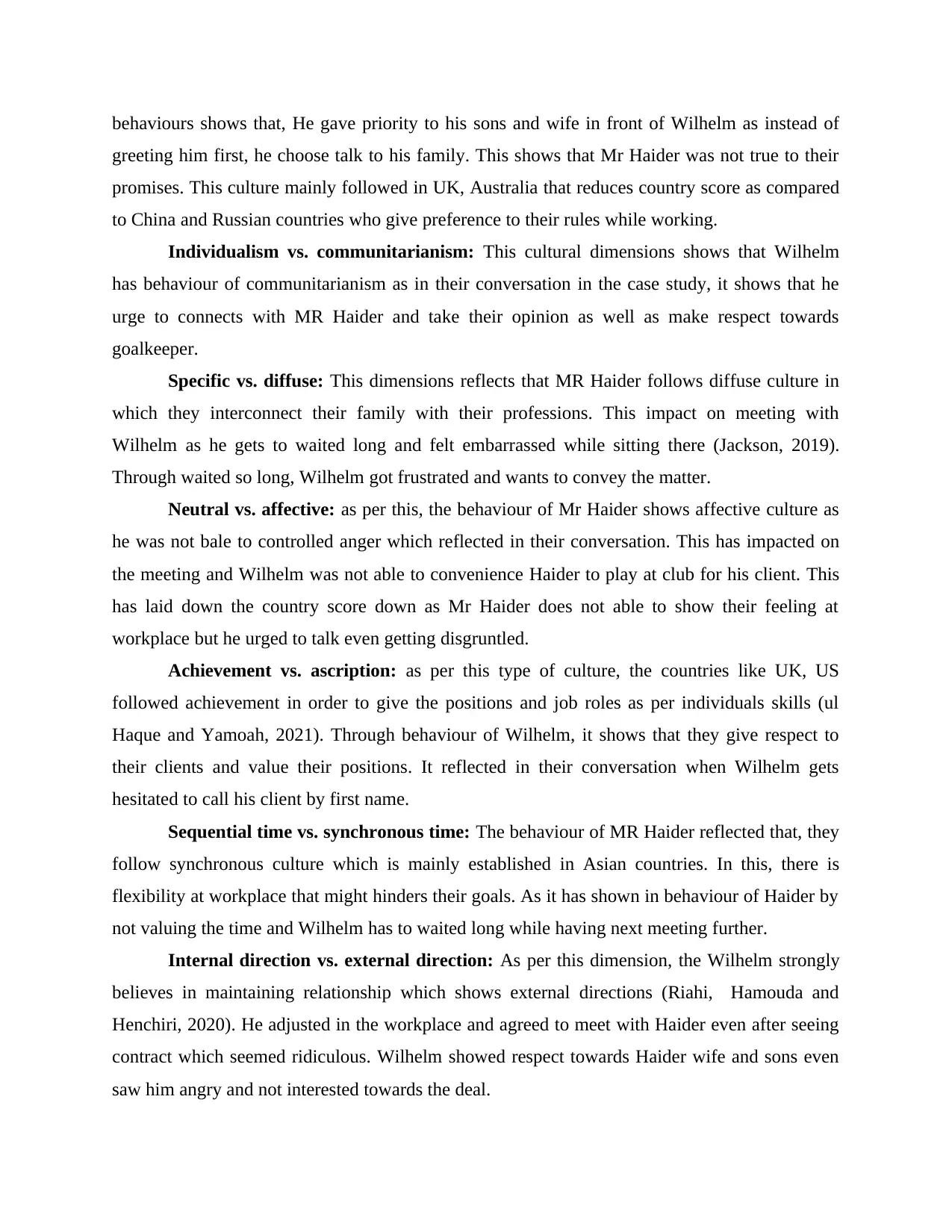
behaviours shows that, He gave priority to his sons and wife in front of Wilhelm as instead of
greeting him first, he choose talk to his family. This shows that Mr Haider was not true to their
promises. This culture mainly followed in UK, Australia that reduces country score as compared
to China and Russian countries who give preference to their rules while working.
Individualism vs. communitarianism: This cultural dimensions shows that Wilhelm
has behaviour of communitarianism as in their conversation in the case study, it shows that he
urge to connects with MR Haider and take their opinion as well as make respect towards
goalkeeper.
Specific vs. diffuse: This dimensions reflects that MR Haider follows diffuse culture in
which they interconnect their family with their professions. This impact on meeting with
Wilhelm as he gets to waited long and felt embarrassed while sitting there (Jackson, 2019).
Through waited so long, Wilhelm got frustrated and wants to convey the matter.
Neutral vs. affective: as per this, the behaviour of Mr Haider shows affective culture as
he was not bale to controlled anger which reflected in their conversation. This has impacted on
the meeting and Wilhelm was not able to convenience Haider to play at club for his client. This
has laid down the country score down as Mr Haider does not able to show their feeling at
workplace but he urged to talk even getting disgruntled.
Achievement vs. ascription: as per this type of culture, the countries like UK, US
followed achievement in order to give the positions and job roles as per individuals skills (ul
Haque and Yamoah, 2021). Through behaviour of Wilhelm, it shows that they give respect to
their clients and value their positions. It reflected in their conversation when Wilhelm gets
hesitated to call his client by first name.
Sequential time vs. synchronous time: The behaviour of MR Haider reflected that, they
follow synchronous culture which is mainly established in Asian countries. In this, there is
flexibility at workplace that might hinders their goals. As it has shown in behaviour of Haider by
not valuing the time and Wilhelm has to waited long while having next meeting further.
Internal direction vs. external direction: As per this dimension, the Wilhelm strongly
believes in maintaining relationship which shows external directions (Riahi, Hamouda and
Henchiri, 2020). He adjusted in the workplace and agreed to meet with Haider even after seeing
contract which seemed ridiculous. Wilhelm showed respect towards Haider wife and sons even
saw him angry and not interested towards the deal.
greeting him first, he choose talk to his family. This shows that Mr Haider was not true to their
promises. This culture mainly followed in UK, Australia that reduces country score as compared
to China and Russian countries who give preference to their rules while working.
Individualism vs. communitarianism: This cultural dimensions shows that Wilhelm
has behaviour of communitarianism as in their conversation in the case study, it shows that he
urge to connects with MR Haider and take their opinion as well as make respect towards
goalkeeper.
Specific vs. diffuse: This dimensions reflects that MR Haider follows diffuse culture in
which they interconnect their family with their professions. This impact on meeting with
Wilhelm as he gets to waited long and felt embarrassed while sitting there (Jackson, 2019).
Through waited so long, Wilhelm got frustrated and wants to convey the matter.
Neutral vs. affective: as per this, the behaviour of Mr Haider shows affective culture as
he was not bale to controlled anger which reflected in their conversation. This has impacted on
the meeting and Wilhelm was not able to convenience Haider to play at club for his client. This
has laid down the country score down as Mr Haider does not able to show their feeling at
workplace but he urged to talk even getting disgruntled.
Achievement vs. ascription: as per this type of culture, the countries like UK, US
followed achievement in order to give the positions and job roles as per individuals skills (ul
Haque and Yamoah, 2021). Through behaviour of Wilhelm, it shows that they give respect to
their clients and value their positions. It reflected in their conversation when Wilhelm gets
hesitated to call his client by first name.
Sequential time vs. synchronous time: The behaviour of MR Haider reflected that, they
follow synchronous culture which is mainly established in Asian countries. In this, there is
flexibility at workplace that might hinders their goals. As it has shown in behaviour of Haider by
not valuing the time and Wilhelm has to waited long while having next meeting further.
Internal direction vs. external direction: As per this dimension, the Wilhelm strongly
believes in maintaining relationship which shows external directions (Riahi, Hamouda and
Henchiri, 2020). He adjusted in the workplace and agreed to meet with Haider even after seeing
contract which seemed ridiculous. Wilhelm showed respect towards Haider wife and sons even
saw him angry and not interested towards the deal.
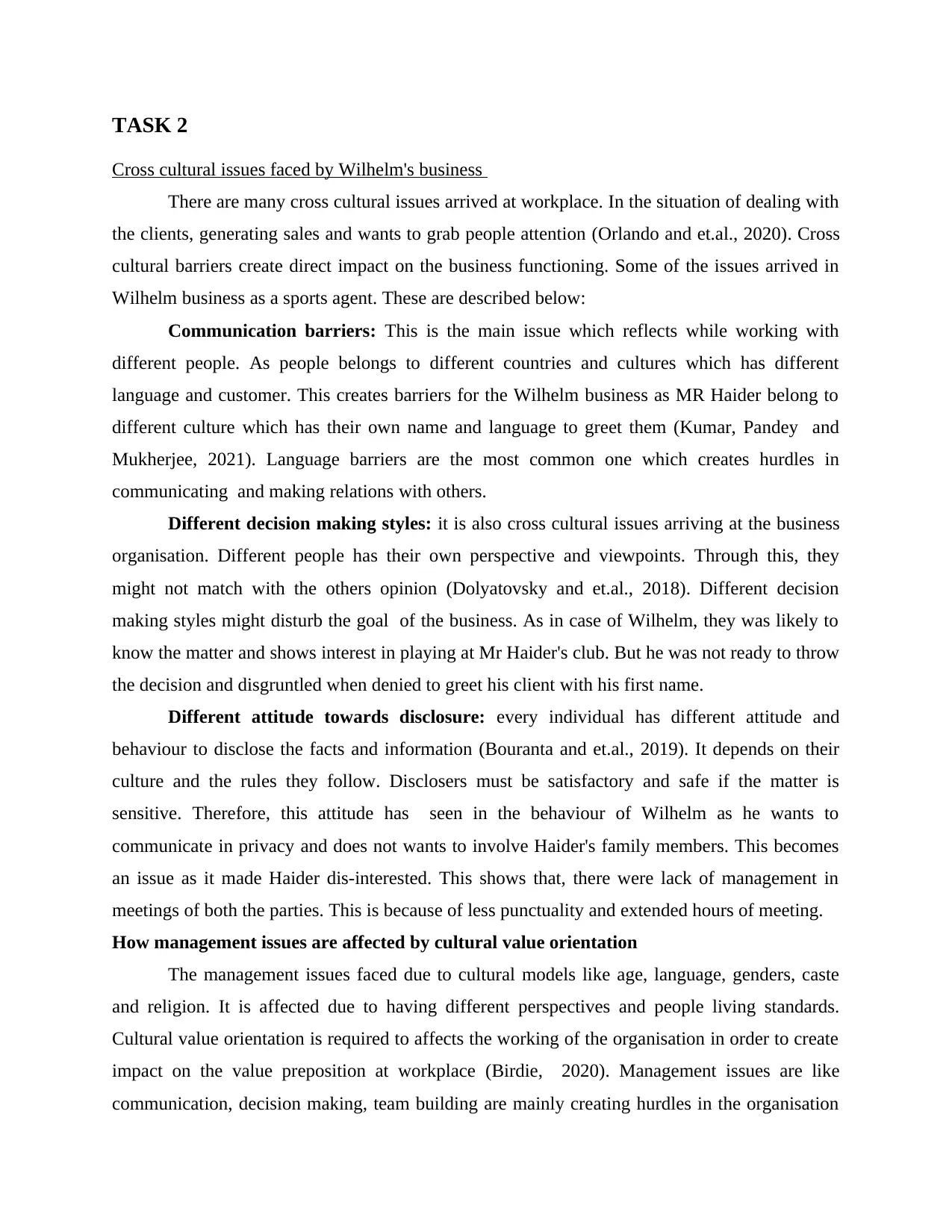
TASK 2
Cross cultural issues faced by Wilhelm's business
There are many cross cultural issues arrived at workplace. In the situation of dealing with
the clients, generating sales and wants to grab people attention (Orlando and et.al., 2020). Cross
cultural barriers create direct impact on the business functioning. Some of the issues arrived in
Wilhelm business as a sports agent. These are described below:
Communication barriers: This is the main issue which reflects while working with
different people. As people belongs to different countries and cultures which has different
language and customer. This creates barriers for the Wilhelm business as MR Haider belong to
different culture which has their own name and language to greet them (Kumar, Pandey and
Mukherjee, 2021). Language barriers are the most common one which creates hurdles in
communicating and making relations with others.
Different decision making styles: it is also cross cultural issues arriving at the business
organisation. Different people has their own perspective and viewpoints. Through this, they
might not match with the others opinion (Dolyatovsky and et.al., 2018). Different decision
making styles might disturb the goal of the business. As in case of Wilhelm, they was likely to
know the matter and shows interest in playing at Mr Haider's club. But he was not ready to throw
the decision and disgruntled when denied to greet his client with his first name.
Different attitude towards disclosure: every individual has different attitude and
behaviour to disclose the facts and information (Bouranta and et.al., 2019). It depends on their
culture and the rules they follow. Disclosers must be satisfactory and safe if the matter is
sensitive. Therefore, this attitude has seen in the behaviour of Wilhelm as he wants to
communicate in privacy and does not wants to involve Haider's family members. This becomes
an issue as it made Haider dis-interested. This shows that, there were lack of management in
meetings of both the parties. This is because of less punctuality and extended hours of meeting.
How management issues are affected by cultural value orientation
The management issues faced due to cultural models like age, language, genders, caste
and religion. It is affected due to having different perspectives and people living standards.
Cultural value orientation is required to affects the working of the organisation in order to create
impact on the value preposition at workplace (Birdie, 2020). Management issues are like
communication, decision making, team building are mainly creating hurdles in the organisation
Cross cultural issues faced by Wilhelm's business
There are many cross cultural issues arrived at workplace. In the situation of dealing with
the clients, generating sales and wants to grab people attention (Orlando and et.al., 2020). Cross
cultural barriers create direct impact on the business functioning. Some of the issues arrived in
Wilhelm business as a sports agent. These are described below:
Communication barriers: This is the main issue which reflects while working with
different people. As people belongs to different countries and cultures which has different
language and customer. This creates barriers for the Wilhelm business as MR Haider belong to
different culture which has their own name and language to greet them (Kumar, Pandey and
Mukherjee, 2021). Language barriers are the most common one which creates hurdles in
communicating and making relations with others.
Different decision making styles: it is also cross cultural issues arriving at the business
organisation. Different people has their own perspective and viewpoints. Through this, they
might not match with the others opinion (Dolyatovsky and et.al., 2018). Different decision
making styles might disturb the goal of the business. As in case of Wilhelm, they was likely to
know the matter and shows interest in playing at Mr Haider's club. But he was not ready to throw
the decision and disgruntled when denied to greet his client with his first name.
Different attitude towards disclosure: every individual has different attitude and
behaviour to disclose the facts and information (Bouranta and et.al., 2019). It depends on their
culture and the rules they follow. Disclosers must be satisfactory and safe if the matter is
sensitive. Therefore, this attitude has seen in the behaviour of Wilhelm as he wants to
communicate in privacy and does not wants to involve Haider's family members. This becomes
an issue as it made Haider dis-interested. This shows that, there were lack of management in
meetings of both the parties. This is because of less punctuality and extended hours of meeting.
How management issues are affected by cultural value orientation
The management issues faced due to cultural models like age, language, genders, caste
and religion. It is affected due to having different perspectives and people living standards.
Cultural value orientation is required to affects the working of the organisation in order to create
impact on the value preposition at workplace (Birdie, 2020). Management issues are like
communication, decision making, team building are mainly creating hurdles in the organisation
⊘ This is a preview!⊘
Do you want full access?
Subscribe today to unlock all pages.

Trusted by 1+ million students worldwide
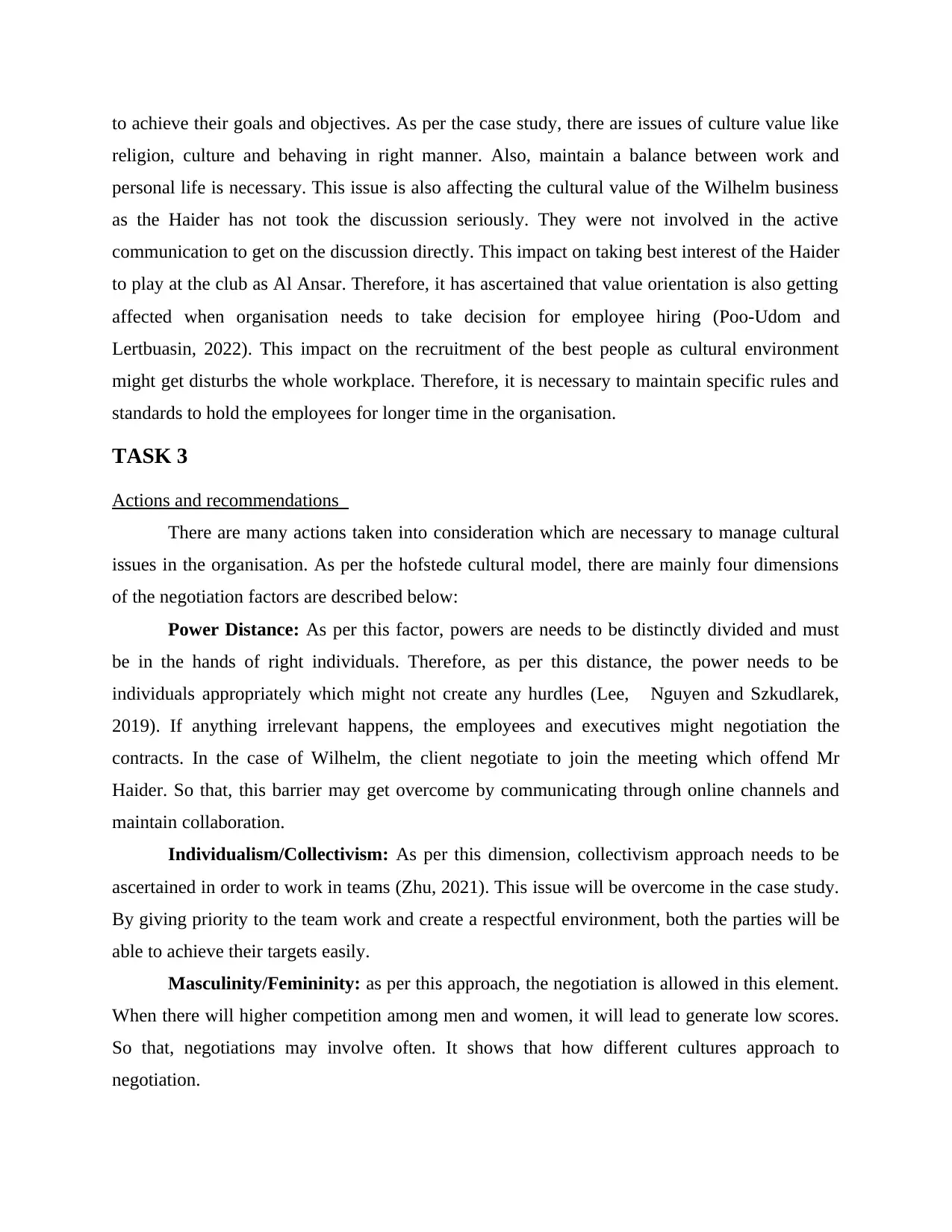
to achieve their goals and objectives. As per the case study, there are issues of culture value like
religion, culture and behaving in right manner. Also, maintain a balance between work and
personal life is necessary. This issue is also affecting the cultural value of the Wilhelm business
as the Haider has not took the discussion seriously. They were not involved in the active
communication to get on the discussion directly. This impact on taking best interest of the Haider
to play at the club as Al Ansar. Therefore, it has ascertained that value orientation is also getting
affected when organisation needs to take decision for employee hiring (Poo-Udom and
Lertbuasin, 2022). This impact on the recruitment of the best people as cultural environment
might get disturbs the whole workplace. Therefore, it is necessary to maintain specific rules and
standards to hold the employees for longer time in the organisation.
TASK 3
Actions and recommendations
There are many actions taken into consideration which are necessary to manage cultural
issues in the organisation. As per the hofstede cultural model, there are mainly four dimensions
of the negotiation factors are described below:
Power Distance: As per this factor, powers are needs to be distinctly divided and must
be in the hands of right individuals. Therefore, as per this distance, the power needs to be
individuals appropriately which might not create any hurdles (Lee, Nguyen and Szkudlarek,
2019). If anything irrelevant happens, the employees and executives might negotiation the
contracts. In the case of Wilhelm, the client negotiate to join the meeting which offend Mr
Haider. So that, this barrier may get overcome by communicating through online channels and
maintain collaboration.
Individualism/Collectivism: As per this dimension, collectivism approach needs to be
ascertained in order to work in teams (Zhu, 2021). This issue will be overcome in the case study.
By giving priority to the team work and create a respectful environment, both the parties will be
able to achieve their targets easily.
Masculinity/Femininity: as per this approach, the negotiation is allowed in this element.
When there will higher competition among men and women, it will lead to generate low scores.
So that, negotiations may involve often. It shows that how different cultures approach to
negotiation.
religion, culture and behaving in right manner. Also, maintain a balance between work and
personal life is necessary. This issue is also affecting the cultural value of the Wilhelm business
as the Haider has not took the discussion seriously. They were not involved in the active
communication to get on the discussion directly. This impact on taking best interest of the Haider
to play at the club as Al Ansar. Therefore, it has ascertained that value orientation is also getting
affected when organisation needs to take decision for employee hiring (Poo-Udom and
Lertbuasin, 2022). This impact on the recruitment of the best people as cultural environment
might get disturbs the whole workplace. Therefore, it is necessary to maintain specific rules and
standards to hold the employees for longer time in the organisation.
TASK 3
Actions and recommendations
There are many actions taken into consideration which are necessary to manage cultural
issues in the organisation. As per the hofstede cultural model, there are mainly four dimensions
of the negotiation factors are described below:
Power Distance: As per this factor, powers are needs to be distinctly divided and must
be in the hands of right individuals. Therefore, as per this distance, the power needs to be
individuals appropriately which might not create any hurdles (Lee, Nguyen and Szkudlarek,
2019). If anything irrelevant happens, the employees and executives might negotiation the
contracts. In the case of Wilhelm, the client negotiate to join the meeting which offend Mr
Haider. So that, this barrier may get overcome by communicating through online channels and
maintain collaboration.
Individualism/Collectivism: As per this dimension, collectivism approach needs to be
ascertained in order to work in teams (Zhu, 2021). This issue will be overcome in the case study.
By giving priority to the team work and create a respectful environment, both the parties will be
able to achieve their targets easily.
Masculinity/Femininity: as per this approach, the negotiation is allowed in this element.
When there will higher competition among men and women, it will lead to generate low scores.
So that, negotiations may involve often. It shows that how different cultures approach to
negotiation.
Paraphrase This Document
Need a fresh take? Get an instant paraphrase of this document with our AI Paraphraser
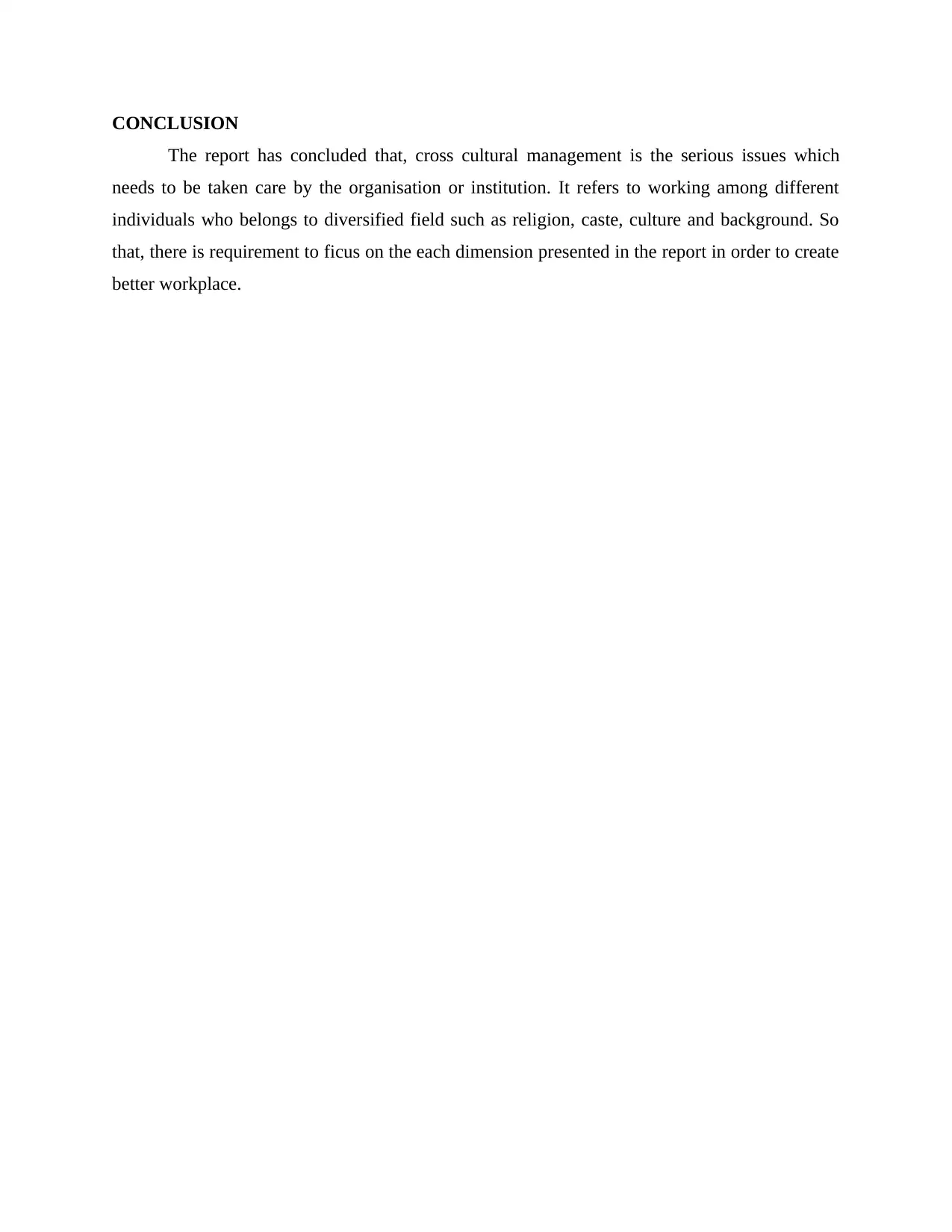
CONCLUSION
The report has concluded that, cross cultural management is the serious issues which
needs to be taken care by the organisation or institution. It refers to working among different
individuals who belongs to diversified field such as religion, caste, culture and background. So
that, there is requirement to ficus on the each dimension presented in the report in order to create
better workplace.
The report has concluded that, cross cultural management is the serious issues which
needs to be taken care by the organisation or institution. It refers to working among different
individuals who belongs to diversified field such as religion, caste, culture and background. So
that, there is requirement to ficus on the each dimension presented in the report in order to create
better workplace.
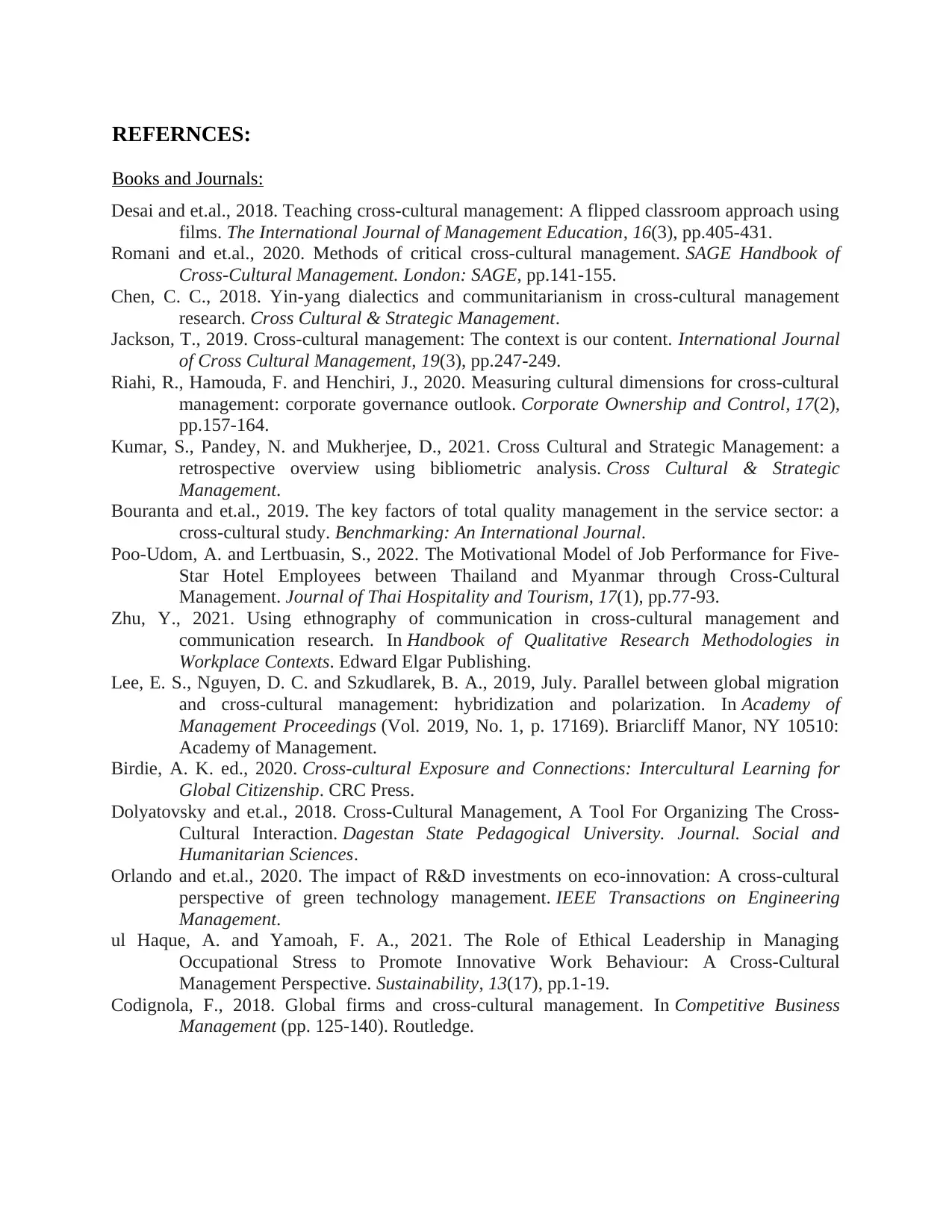
REFERNCES:
Books and Journals:
Desai and et.al., 2018. Teaching cross-cultural management: A flipped classroom approach using
films. The International Journal of Management Education, 16(3), pp.405-431.
Romani and et.al., 2020. Methods of critical cross-cultural management. SAGE Handbook of
Cross-Cultural Management. London: SAGE, pp.141-155.
Chen, C. C., 2018. Yin-yang dialectics and communitarianism in cross-cultural management
research. Cross Cultural & Strategic Management.
Jackson, T., 2019. Cross-cultural management: The context is our content. International Journal
of Cross Cultural Management, 19(3), pp.247-249.
Riahi, R., Hamouda, F. and Henchiri, J., 2020. Measuring cultural dimensions for cross-cultural
management: corporate governance outlook. Corporate Ownership and Control, 17(2),
pp.157-164.
Kumar, S., Pandey, N. and Mukherjee, D., 2021. Cross Cultural and Strategic Management: a
retrospective overview using bibliometric analysis. Cross Cultural & Strategic
Management.
Bouranta and et.al., 2019. The key factors of total quality management in the service sector: a
cross-cultural study. Benchmarking: An International Journal.
Poo-Udom, A. and Lertbuasin, S., 2022. The Motivational Model of Job Performance for Five-
Star Hotel Employees between Thailand and Myanmar through Cross-Cultural
Management. Journal of Thai Hospitality and Tourism, 17(1), pp.77-93.
Zhu, Y., 2021. Using ethnography of communication in cross-cultural management and
communication research. In Handbook of Qualitative Research Methodologies in
Workplace Contexts. Edward Elgar Publishing.
Lee, E. S., Nguyen, D. C. and Szkudlarek, B. A., 2019, July. Parallel between global migration
and cross-cultural management: hybridization and polarization. In Academy of
Management Proceedings (Vol. 2019, No. 1, p. 17169). Briarcliff Manor, NY 10510:
Academy of Management.
Birdie, A. K. ed., 2020. Cross-cultural Exposure and Connections: Intercultural Learning for
Global Citizenship. CRC Press.
Dolyatovsky and et.al., 2018. Cross-Cultural Management, A Tool For Organizing The Cross-
Cultural Interaction. Dagestan State Pedagogical University. Journal. Social and
Humanitarian Sciences.
Orlando and et.al., 2020. The impact of R&D investments on eco-innovation: A cross-cultural
perspective of green technology management. IEEE Transactions on Engineering
Management.
ul Haque, A. and Yamoah, F. A., 2021. The Role of Ethical Leadership in Managing
Occupational Stress to Promote Innovative Work Behaviour: A Cross-Cultural
Management Perspective. Sustainability, 13(17), pp.1-19.
Codignola, F., 2018. Global firms and cross-cultural management. In Competitive Business
Management (pp. 125-140). Routledge.
Books and Journals:
Desai and et.al., 2018. Teaching cross-cultural management: A flipped classroom approach using
films. The International Journal of Management Education, 16(3), pp.405-431.
Romani and et.al., 2020. Methods of critical cross-cultural management. SAGE Handbook of
Cross-Cultural Management. London: SAGE, pp.141-155.
Chen, C. C., 2018. Yin-yang dialectics and communitarianism in cross-cultural management
research. Cross Cultural & Strategic Management.
Jackson, T., 2019. Cross-cultural management: The context is our content. International Journal
of Cross Cultural Management, 19(3), pp.247-249.
Riahi, R., Hamouda, F. and Henchiri, J., 2020. Measuring cultural dimensions for cross-cultural
management: corporate governance outlook. Corporate Ownership and Control, 17(2),
pp.157-164.
Kumar, S., Pandey, N. and Mukherjee, D., 2021. Cross Cultural and Strategic Management: a
retrospective overview using bibliometric analysis. Cross Cultural & Strategic
Management.
Bouranta and et.al., 2019. The key factors of total quality management in the service sector: a
cross-cultural study. Benchmarking: An International Journal.
Poo-Udom, A. and Lertbuasin, S., 2022. The Motivational Model of Job Performance for Five-
Star Hotel Employees between Thailand and Myanmar through Cross-Cultural
Management. Journal of Thai Hospitality and Tourism, 17(1), pp.77-93.
Zhu, Y., 2021. Using ethnography of communication in cross-cultural management and
communication research. In Handbook of Qualitative Research Methodologies in
Workplace Contexts. Edward Elgar Publishing.
Lee, E. S., Nguyen, D. C. and Szkudlarek, B. A., 2019, July. Parallel between global migration
and cross-cultural management: hybridization and polarization. In Academy of
Management Proceedings (Vol. 2019, No. 1, p. 17169). Briarcliff Manor, NY 10510:
Academy of Management.
Birdie, A. K. ed., 2020. Cross-cultural Exposure and Connections: Intercultural Learning for
Global Citizenship. CRC Press.
Dolyatovsky and et.al., 2018. Cross-Cultural Management, A Tool For Organizing The Cross-
Cultural Interaction. Dagestan State Pedagogical University. Journal. Social and
Humanitarian Sciences.
Orlando and et.al., 2020. The impact of R&D investments on eco-innovation: A cross-cultural
perspective of green technology management. IEEE Transactions on Engineering
Management.
ul Haque, A. and Yamoah, F. A., 2021. The Role of Ethical Leadership in Managing
Occupational Stress to Promote Innovative Work Behaviour: A Cross-Cultural
Management Perspective. Sustainability, 13(17), pp.1-19.
Codignola, F., 2018. Global firms and cross-cultural management. In Competitive Business
Management (pp. 125-140). Routledge.
⊘ This is a preview!⊘
Do you want full access?
Subscribe today to unlock all pages.

Trusted by 1+ million students worldwide

1 out of 10
Related Documents
Your All-in-One AI-Powered Toolkit for Academic Success.
+13062052269
info@desklib.com
Available 24*7 on WhatsApp / Email
![[object Object]](/_next/static/media/star-bottom.7253800d.svg)
Unlock your academic potential
Copyright © 2020–2025 A2Z Services. All Rights Reserved. Developed and managed by ZUCOL.




